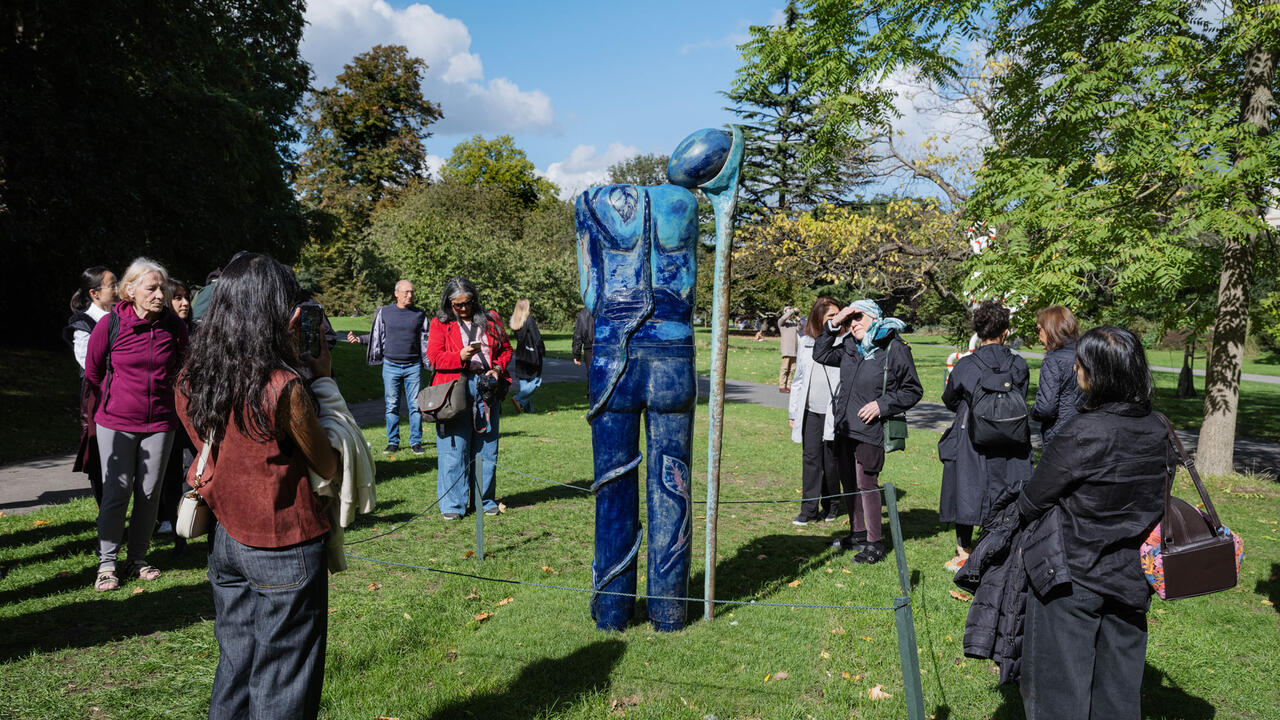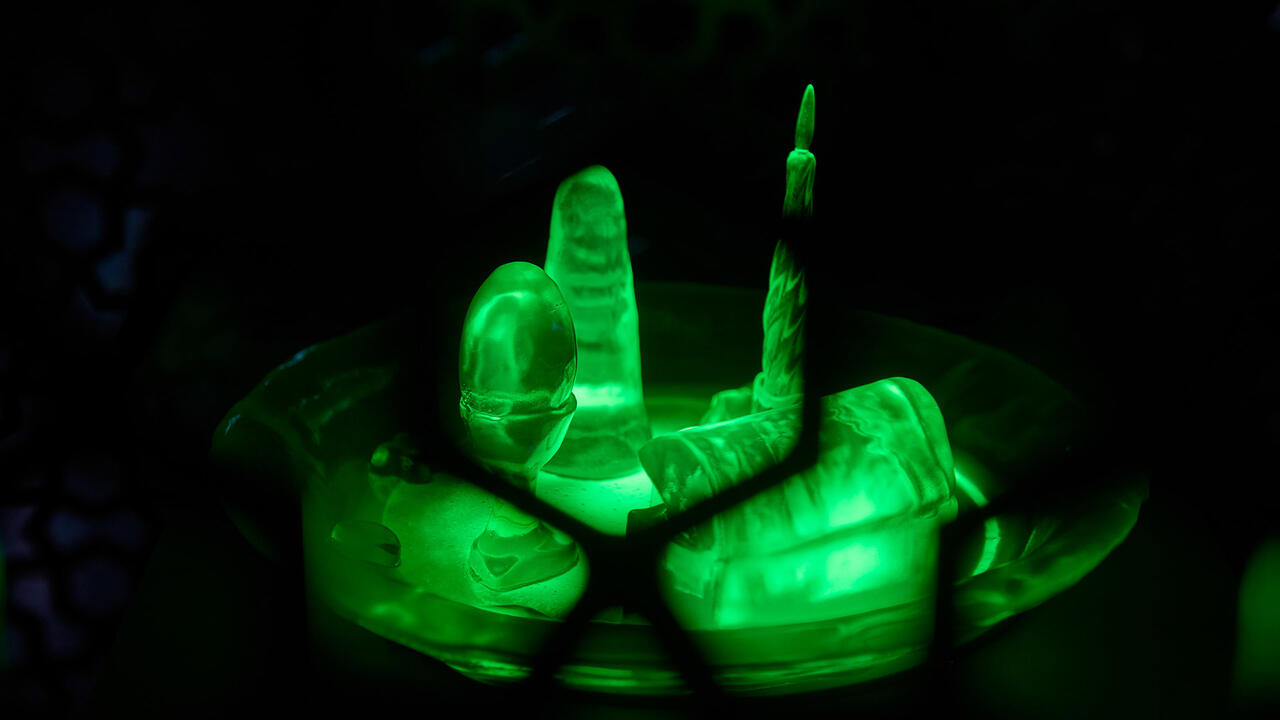Ruptured Histories: How Hew Locke is Peeling Back the Layers of Britain’s Colonial Past
A new exhibition at Birmingham’s Ikon Gallery feels at once reminiscent and foreboding
A new exhibition at Birmingham’s Ikon Gallery feels at once reminiscent and foreboding

Entering Birmingham’s Ikon Gallery, you would be forgiven for thinking the walls are moving. Carnivalesque characters, ceremonially dressed in outfits spanning military regalia to Benin masks, dangle down in strings of glistening black beads, almost seeming to sway to the faint calypso tones filtering in from the next room.
The larger-than-life mythical figures – animal, human and other – that comprise The Nameless (2010) are mesmerizingly ambiguous. Captured parading around the periphery of the gallery to an unknown destination, they appear in seemingly high spirits, somewhere between celebration and worship; while the threat of warfare is ever present, with skulls and automatic weapons extending from their bodies. The installation is equally unnerving and hypnotic. Swept up in a momentary trance, I feel compelled to join the troupe.

‘Here’s the Thing’ is the most comprehensive exhibition to date of work by London-based Hew Locke. The artist is best known as a sculptor; however, this presentation foregrounds his range and practice, rooted in the piecing together and layering of materials. Ships and seafaring haunt the show, tracing a long-lasting investment that’s both personal and historical. Born in Scotland, Locke’s family moved to his father’s home country of Guyana when he was five years old, where he remained for his formative years. They had journeyed there by boat, and when he returned to England to study, he also travelled by sea. Guyana’s name itself means ‘The Land of Many Waters’ and, of course, the history of the country is inextricably bound to the Dutch and British ships which transported enslaved Africans there from the early 17th century onwards. In Locke’s hands, sailing vessels take on complex and multiple meanings.
In his film, The Tourists (2015), Locke layers carnival costumes and wreaths over ‘sailors’ posing on HMS Belfast, a World War II Royal Navy ship that was converted into a museum in 1971, complete with dioramas populated by life-sized mannequins. In Locke’s re-imagined scenario of the ship’s final voyage, the crew are getting ready to stop in Trinidad and take part in carnival. The calypso music overheard from the previous room is part of the soundtrack here, the sweet melody of Harry Belafonte’s ‘Brown Skin Girl’ (1956) jarring uncomfortably with the reality of the lyrics – sailors and sex tourism.

Layering is a technique that recurs throughout Locke’s work. On the second floor of the exhibition, Hinterland (2013), a large-scale photograph of a statue of Queen Victoria in Georgetown, is overlaid with ghostly negatives of the mythical figures that appear in The Nameless, painted in acrylic. The statue was pulled down and discarded when Guyana became a republic in 1970, then later re-erected. Now decrepit and missing a hand, here it is washed over with acid yellow and surrounded by apparitions, appearing haunted rather than authoritarian; a metaphor perhaps for a ruptured colonial fantasy. A palimpsest, Hinterland reminds us that traces of the past always remain and are not easily abandoned.
In an interview, Locke reveals that his work is ‘about much more than what it looks like.’ Nonetheless, it is difficult not to see the indelible imprint of empire. The pinnacle of this show is Armada (2019), a flotilla of innumerable model boats of various sizes, suspended from the ceiling. It is stunning, magnificent in scale, solemn and disquieting in mood. An earlier version appeared at the Venice Biennale in 2017, but here the boats are larger in number, the gallery’s vaulted ceiling giving it a reverential air. Visitors are anxious to spot the Empire Windrush among the flotilla; and yet its reproduction here is miniscule, reminding us that it is just a fragment of an irreducible story. Locke does not offer the audience any straightforward narrative, instead asking us to peel back layers of entangled histories and memories; references that may seem disjointed on the surface are inextricably bound together. ‘Here’s The Thing’ conjures a heady, surreal atmosphere that feels at once reminiscent and foreboding, warning us that neither the past nor the future can be escaped.
‘Hew Locke: Here’s The Thing’ is at the Ikon Gallery, Birmingham, UK, until 2 June, before travelling to the Kemper Museum of Contemporary Art, Kansas City, USA, Missouri and Colby College Museum of Art, Maine.
Main image: Hew Locke, Armada, 2019, mixed media sculptures. Courtesy: the artist and Ikon, Birmingham; photograph: Tom Bird





















